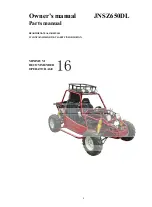
Operation
42
●
Sand
●
Rocks
●
Grass
●
Bare pavement
Other surfaces that should be avoided for the
sake of drive track and slide runner life are:
●
Glare ice surfaces
●
Snow mixed with a lot of dirt and sand
All of the above surfaces have one thing in
common in regard to drive track and slide run-
ners: little or no lubricating ability. Drive track
and all slide rail systems require lubrication
(snow or water) between the slide runners
and the slide metal. In the absence of lubrica-
tion, the slide runners will rapidly wear and in
severe cases, literally melt away, and the
drive track will be subject to damage or failure.
Also traction aids such as studs, cleats, etc.,
may cause further track damage or failure.
WARNING
EWS00280
Drive track damage or failure could result
in loss of braking ability and snowmobile
control, which could cause an accident.
●
Always check the drive track for damage
or maladjustment before operating the
snowmobile.
●
Do not operate the snowmobile if you
find damage to the drive track.
NOTICE
ECS00350
Ride on fresh snow frequently. Operating
on ice or hard-packed snow will rapidly
wear the slide runners.
ESU11350
Maximizing drive track life
Recommendations
Track tension
During initial break-in, the new drive track will
tend to stretch quickly as the track settles. Be
sure to correct the track tension and align-
ment frequently. (See page 69 for adjustment
procedures.) A loose track can slip (ratchet),
derail or catch on suspension parts causing
severe damage. Do not overtighten the drive
track, otherwise it may increase the friction
between the track and the slide runners, re-
sulting in the rapid wear of both components.
Also, this may put an excessive load on the
suspension components, resulting in compo-
nent failure.
Marginal snow
The drive track and the slide runners are lubri-
cated and cooled by snow and water. To pre-
vent the drive track and slide runners from
overheating, avoid sustained high-speed us-
age in areas such as icy trails, frozen lakes
and rivers that have minimal snow coverage.
An overheated track will be weakened inter-
nally, which may cause failure or damage.
Off-trail riding
Avoid off-trail riding until there is sufficient
snow coverage. It generally takes several feet
of snow to provide a good overall base to
properly cover debris, such as rocks, logs,
etc. If snow coverage is not sufficient, stay on
trails to avoid impact damage to the drive
track.
Studded track
In general, track life will be shortened when
studs are installed. Drilling stud holes into the
drive track will cut the internal fibers, which
weakens the track. Avoid spinning the drive
track. Studs may catch on an object and pull
out of the track, leaving tears and damage
around the already weakened area. To mini-
mize possible damage, consult your stud
manufacturer for installation and stud pattern
recommendations.
Yamaha does not recommend track stud-
ding.
U8HG10E0.book Page 42 Tuesday, May 18, 2010 5:39 PM
















































